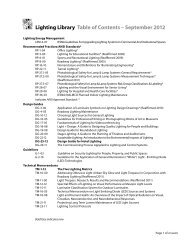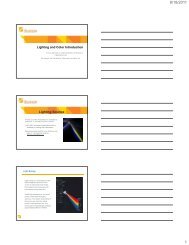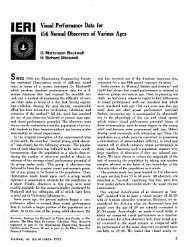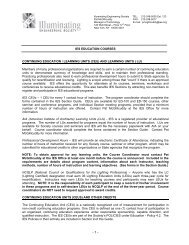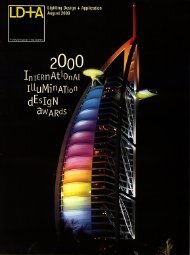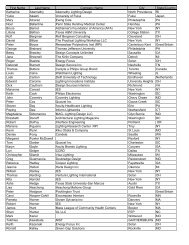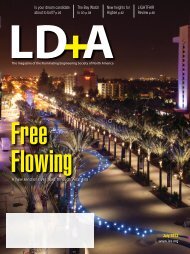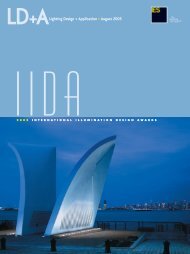Residential Lighting - Illuminating Engineering Society
Residential Lighting - Illuminating Engineering Society
Residential Lighting - Illuminating Engineering Society
Create successful ePaper yourself
Turn your PDF publications into a flip-book with our unique Google optimized e-Paper software.
JP. 1997. Photic Regulation of<br />
Melatonin in Humans: Ocular and<br />
neural Signal Transduction. J Biol<br />
Rhythms, 12(6): 537 - 546<br />
Davis S, Mirick DK, Stevens RG.<br />
2001. Night shift work, light at<br />
night, and risk of breast cancer. J<br />
Natl Cancer Inst 93(20): 1557-<br />
1562.<br />
Figueiro MG, Rea MS, Boyce P,<br />
White R, Kolberg K. 2001. The<br />
effects of bright light on day and<br />
night shift nurses’ performance and<br />
well-being in the NICU. Neonatal<br />
Intens. Care 14(1): 29-32.<br />
Hansen J. 2001. Light at night,<br />
shiftwork, and breast cancer risk. J<br />
Natl Cancer Inst 93(20): 1513-<br />
1515.<br />
Herbert M, Martin SK, Lee C,<br />
Eastman CI. 2002. The effects of<br />
prior light history on the suppression<br />
of melatonin by light in<br />
humans. J Pineal Res 33: 198-203.<br />
Lewy AJ, Wehr TA, Goowin FK, et<br />
al. 1980. Light suppresses melatonin<br />
secretion in humans. Science,<br />
210: 1267-1269.<br />
Lynch HJ, Deng MH, Wurtman<br />
RJ. 1985. Indirect Effects of Light:<br />
Ecological and Ethological Considerations.<br />
The Medical and Biological<br />
Effects of Light. Annals of<br />
the New York Academy of Sciences<br />
453: 231 – 241.<br />
Miller CL, White R, Whitman TL,<br />
O’Callaghan MF, Maxwell SE. 1995.<br />
The effects of cycled versus noncycled<br />
lighting on growth and development<br />
in preterm infants. Infant<br />
Behav Develop 18(1): 87-95.<br />
Rea MS, Figueiro MG, Bullough<br />
JD. 2002. Circadian photobiology:<br />
An emerging framework for lighting<br />
practice and research. Light. Res.<br />
Technol. 34(3): 177-190.<br />
Schernhammer ES, Laden F,<br />
Speizer FE, Willett WC, Hunter DJ,<br />
Kawachi I, Colditz GA. 2001.<br />
Rotating night shifts and risk of<br />
breast cancer in women participating<br />
in the nurses’ health study. J Natl<br />
Cancer Inst 93(20): 1563-1568.<br />
Van Someren EJW, Kessler A,<br />
Mirmirann M, Swaab DF. 1997.<br />
Indirect bright light improves circadian<br />
rest-activity rhythm disturbances<br />
in demented patients. Biol.<br />
Psychiatry 1997; 41: 955-963.<br />
www.iesna.org<br />
Before a stage show comes to<br />
Broadway it opens “on the<br />
road” to get the kinks out of<br />
it. Often the producers hire a “show<br />
doctor” to make changes that will<br />
help insure the play’s success in<br />
New York.<br />
Something similar happens with<br />
a developer’s speculative office<br />
building. A construction cost of<br />
$200/sq ft for a million square foot<br />
office building makes for a risky investment,<br />
even with a major tenant<br />
lined up before breaking ground.<br />
Since you can’t try out an office<br />
building on the road, many developers<br />
engage an architect’s architect<br />
Energy<br />
conservationists<br />
recommend that<br />
available daylight<br />
be used to<br />
reduce the<br />
electric load,<br />
which can easily<br />
be done in an<br />
office only 15 ft<br />
deep<br />
to configure the building so that<br />
when it is built in New York, or in<br />
any major US city, it gets the maximum<br />
yield in the form of rental to<br />
insure its success.<br />
The best known of these building<br />
gurus is Der Scutt, who is a<br />
Fellow of the AIA as well as the<br />
IESNA. I turned to him for help in<br />
preparing a talk for the Master<br />
Class in <strong>Lighting</strong> for Architects and<br />
Designers, produced each year in<br />
New York by Sonny Sonnenfeld, in<br />
association with Paul Gregory and<br />
Jonathan Speirs. Scutt pointed out<br />
that the size of the plot and the<br />
zoning of the site determines the<br />
footprint and size of the building<br />
and the spacing of the structural<br />
steel. The most economical module<br />
for a developer’s building is five<br />
feet, which dictates the spacing of<br />
the columns and the size of the<br />
various offices.<br />
Some tenants are large corporations<br />
with office buildings throughout<br />
the country. They have their<br />
own formula for space allocation. A<br />
large communication company has<br />
seven different sized private<br />
ENERGY<br />
CONCERNS<br />
offices, one for each of its executive<br />
levels, and has rules for how<br />
many persons have to share a “private”<br />
office, and how many square<br />
feet to allow for each occupant in<br />
an open plan area.<br />
Der Scutt told me that, in general,<br />
for a building to reach its maximum<br />
rental potential, it should have<br />
a 15 ft deep perimeter zone for private<br />
offices, each one a multiple of<br />
5 ft, with the smallest office 10 ft<br />
wide along the window wall by 15 ft<br />
deep, and wider spaces for executives<br />
and conference rooms. Then,<br />
proceeding inward toward the core,<br />
the floor plan should allow 5 ft for a<br />
corridor and 10 feet for secretarial<br />
offices and records. If the perimeter<br />
offices have glass partitions onto<br />
the corridor, then everyone in that<br />
30-ft-deep exterior zone has a visual<br />
connection to the outdoors,<br />
which we know from the Light Right<br />
Consortium study is highly valued<br />
by employees. Then Scutt recommends<br />
another 5-ft-wide corridor for<br />
passage and past that, interior<br />
offices and conference rooms, the<br />
employee cafeteria and utility areas<br />
and finally, the reception area and<br />
elevator lobby.<br />
The glazing in the windowed<br />
perimeter offices will have coatings<br />
to reduce the sun load, which is<br />
highest in the winter when the sun<br />
is at its lowest, and to retain the<br />
heating or cooling on the inside—<br />
depending on the season. Energy<br />
conservationists recommend that<br />
available daylight be used to reduce<br />
Willard L.<br />
Warren,<br />
PE, LC,<br />
FIESNA<br />
LD+A/February 2003 19




